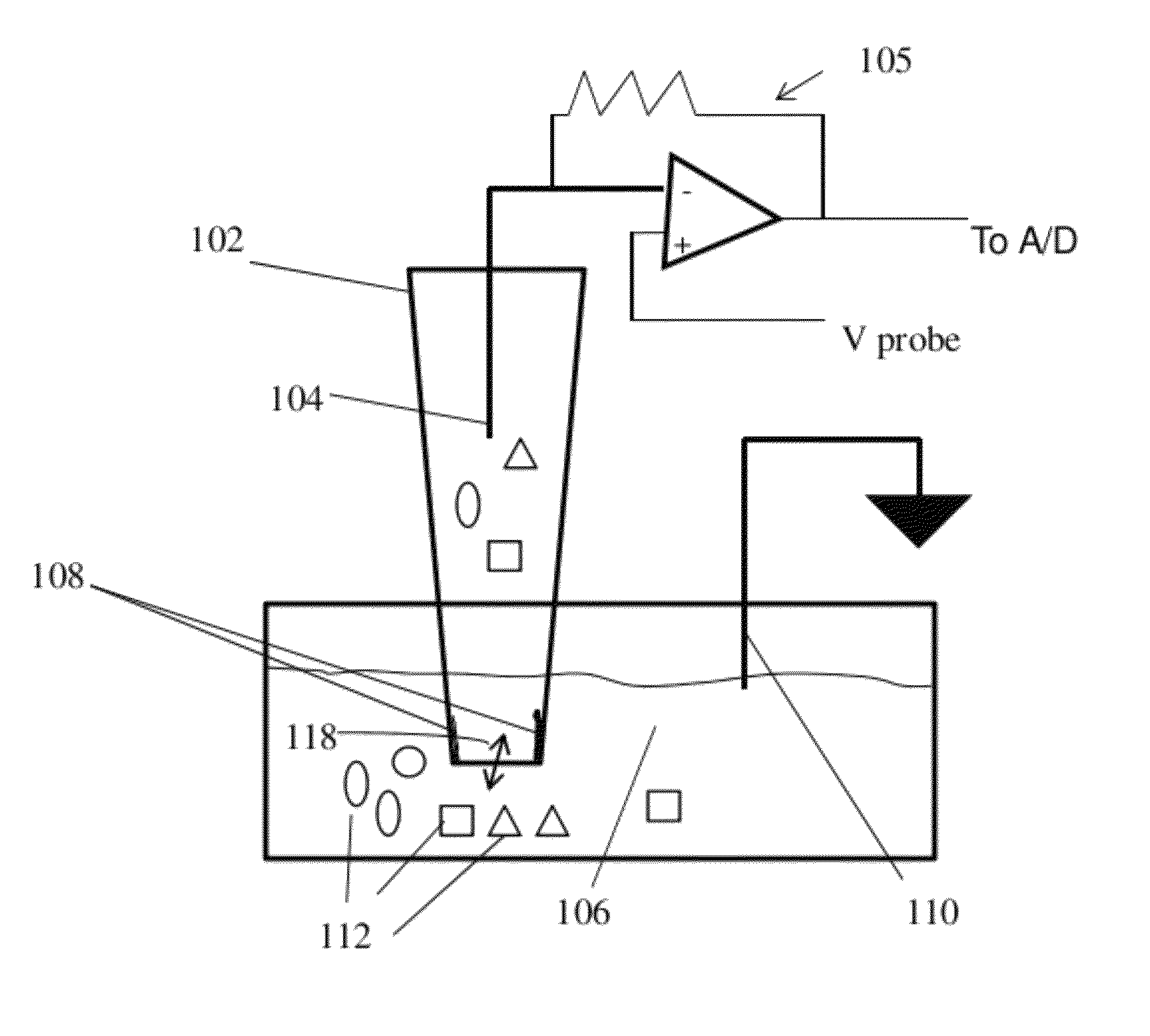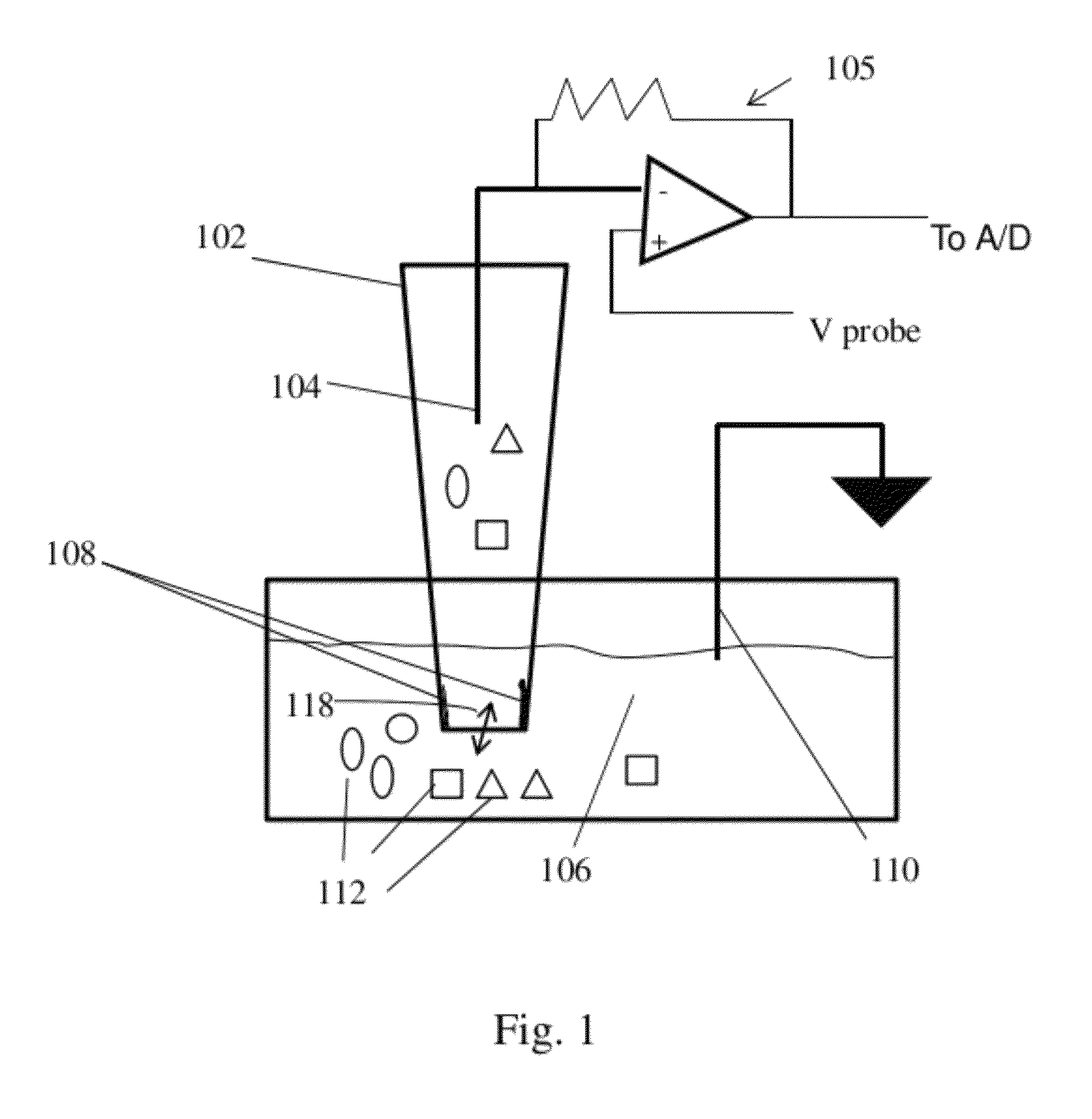Nanopore device for reversible ion and molecule sensing or migration
a nanopore sensor and ion channel technology, applied in the field of nanomaterials, can solve the problems of limiting quantitative measurements of many sensors reported in the literature, challenging reversible binding of analytes to nanopore sensors, and affecting the quality of nanopore sensors
- Summary
- Abstract
- Description
- Claims
- Application Information
AI Technical Summary
Problems solved by technology
Method used
Image
Examples
example 1
Preparation and Characterization of Nanopipette Biosensors with PLL and PAA Polyelectrolyte Layers
[0126]Quartz capillaries with filament (QF100-70-7.5) from Sutter (Novato, Calif.) were used as received and pulled with a Sutter P-2000 laser puller to give nanopipettes. Puller settings used were heat 620, filament 4, velocity 60, delay 170, pull 180. The settings are variable depending on the puller, and were adjusted as needed to provide nanopipettes showing negative ion current rectification with the desired conductance. The pipettes were backfilled with a buffered electrolyte (pH 7 Tris-HCl, 10 mM and KCl, 100 mM) unless otherwise indicated. The two sensors described are twin pipettes from one pulled capillary. Sensor CaM-1 was untreated prior to polyelectrolyte deposition, and CaM-2 was silanized with trimethylchlorosilane (TMCS) using vapor deposition. The nanopipette was placed in a sealed chamber of 0.5 L volume with approximately 0.1 mL of TMCS for 10 minutes. Both pipettes w...
example 2
Selective and Reversible Ca2+ Binding by Calmodulin Immobilized to a Nanopipette
[0129]To achieve reversible and selective ion binding with a biological receptor, nanopipette sensors modified with calmodulin, a calcium binding protein that reversibly chelates calcium (Kd ˜10−6M) with high selectivity, were studied. Electrical sensors using immobilized calmodulin have been previously reported for probing both calcium concentration by Cui et al. in Science vol. 293: pages 1289-1292 in 2001 (“Nanowire nanosensors for highly sensitive and selective detection of biological and chemical species”) and protein-protein interactions by Ivnitiski et (“An amperometric biosensor for real-time analysis of molecular recognition”Bioelectrochem. Bioenerg. 1998, 45(1), 27-32) and by Lin et al. (“Label-free detection of protein-protein interactions using a calmodulin-modified nanowire transistor”Proc. Natl. Acad. Set U.S.A. 2010, 107(3), 1047-1052). Our strategy took into consideration both immobilizat...
example 3
pH-Sensitive Nanopipette Sensors Functionalized with Metal Ion Binding Polymer (Chitosan Binding Cu)
[0133]Sensors of pH were prepared by functionalizing the nanopipette with either an amino-silane, the amine-containing biopolymer chitosan (FIG. 6) or polyelectrolytes containing amines or carboxylic acid groups. The pH sensors showed rapidly reversible response to different buffers from pH 3 to pH 8. The nanopipette was filled with pH 7 electrolyte (100 mM KCl with 10 mM Tris-HCl buffer) and dipped in buffered electrolytes of varying pH (100 mM KCl with 10 mM phosphate / citrate buffer). Ion current was measured while applying a sinusoidal potential from −500 to 500 mV at 5 Hz. Measurements were carried out in a 0.1M KCl solution, buffered with 10 mM phosphate / citrate to the desired pH. Error bars were calculated from at least four different pH measurements with the same sensor (FIG. 6). FIG. 6 shows a comparison of the rectification coefficient for bare and chitosan / PAA-functionalized...
PUM
| Property | Measurement | Unit |
|---|---|---|
| pH | aaaaa | aaaaa |
| pH | aaaaa | aaaaa |
| ion current response | aaaaa | aaaaa |
Abstract
Description
Claims
Application Information
 Login to View More
Login to View More - R&D
- Intellectual Property
- Life Sciences
- Materials
- Tech Scout
- Unparalleled Data Quality
- Higher Quality Content
- 60% Fewer Hallucinations
Browse by: Latest US Patents, China's latest patents, Technical Efficacy Thesaurus, Application Domain, Technology Topic, Popular Technical Reports.
© 2025 PatSnap. All rights reserved.Legal|Privacy policy|Modern Slavery Act Transparency Statement|Sitemap|About US| Contact US: help@patsnap.com



